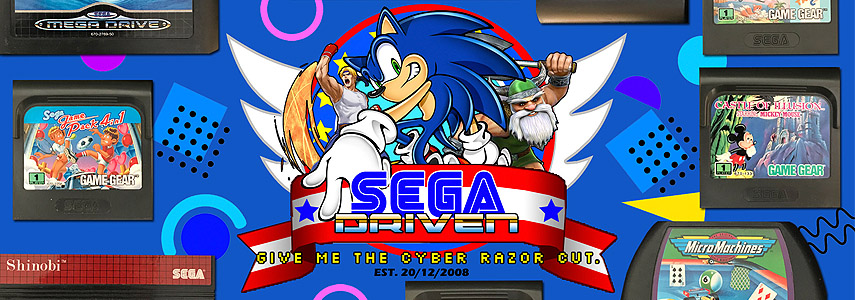It’s funny how Yuji Naka’s career was started by dramatically changing the gameplay formula of a genre that was becoming stale. Back in the late 80s/early 90s, platform games were all the rage thanks to a certain plumber. Then Naka came along with a blue hedgehog that ran at the speed of sound and made an awful lot of developers realise that there was a lot more to the genre then the first though. Now, Naka has gone back to basics; starting his own studio and attempting to revolutionise a gaming genre that has become incredibly overcrowded; the mini-game collection.
The Wii’s software library is dominated with different mini-game collections. Publisher’s are desperate to ride the bandwagon of release titles like Wii Play and Wii Sports with mostly mundane results. Thank God that Naka has decided to through his two cents in and developed Let’s Tap; a mini-game collection with a difference.
Let’s Tap has taken a different approach at using the Wiimote’s motion capabilities. Place the controller face-down on a flat surface and simply tap on the surface to generate the vibrations needed to control one of the five mini-games on offer in this collection. The premise seems quite silly at first but once you’ve started playing you realise just how natural, minimalist and down-right effective the control scheme is.
The first mini-game on offer is Tap Runner. Take control of one of four coloured runners to make a crazy sprint to the finish. Tapping gently and quickly makes the character run while one forceful tap makes the character jump. That’s all there is to it. However, as the courses progress they begin to include a wide variety of gimmicks ranging from hurdles, dash-pads, launch-gates, swinging ropes, springs and the dreaded crushers. Each course has a specific route which can maximise the amount of speed you can use by making good use of the gimmicks on display and using them is your key to winning. Like all the games on offer, the premise is remarkably simple but ridiculously engaging.
Next on the bill is Silent Blocks; a SEGA take on the classic Jenga format. You’re presented with a tower of different blocks which can be removed one at a time. Selecting the block and what direction you want to remove it from then allows you to extract it. This is down with gentle taps in order to not pull other blocks with it, causing the tower to fall and resulting in you losing the game. The harder you tap, the more forceful you remove the block. You can clear large amounts of blocks by making 3 or more of the same colour fall onto each other creating blocks of various colours and rarities for bonus points. Things get more interesting with the inclusion of gimmick blocks such as the Bomb Block which can only be cleared by using it an a combo of similar coloured blocks and explodes after a certain amount of turns. Concentration is the key to this game and it certainly makes for an intense experience.
Now we have the Rhythm Tap game which takes its’ influence from the music-game phenomena. You can choose one of 16 songs to tap along to. Simply tap along to the beat as the beat-indicators move across the screen with the correct strength (light, medium or hard) to score high. There are even sections for you to create your own fill or tap with increasing strength. Gone is the complex control schemes of games like Guitar Hero and Dance Dance Revolution as we welcome the simplicity of tapping. All the songs are typically SEGA with some crazy, retro J-Pop tunes to tap along to. We certainly had a smile on our face with every song we chose.
For the experienced tapper there’s Bubble Voyager. The gameplay is similar in style to classic shmups with you taking control of a mech that automatically flies to the right. It’s up to you to raise the craft by tapping or descending the craft by not tapping. You can also fire missiles at objects and enemies to open up easier routes and uncover hidden items like weapon upgrades and shields. At the end of a section you have to gently land your mech on a landing pad by gently tapping it down to safety for bonus points.
Lastly there’s the Visualizer which is more of an experiment than a game. Choose from a range of visuals like painting with ink, rippling water or launching fireworks and tap with varying strength to unleash different combinations. These are merely eye-candy instead of actual games as you don’t work towards a goal or high-score. But this feature is included similarly to the first Eye-Toy release which had a ‘Playroom’ to allow new users to experiment with the technology in a more casual way. It still remains a fun feature even if it is a little shallow.
We haven’t even talking about the packages aesthetics which hark back to the days of retro SEGA. Most of the time you’ll see flat-shaded polygons, wireframes and vivid colours which are wonderfully nostalgic and perfectly fit the game’s up-beat, 90s electronic sound.
The only let-down with Let’s Tap is the overall lack of content. While each game is wonderfully endearing, they don’t last particularly long making the game’s single player value short-lived. Multiplayer opens up a realm of possibility for the control scheme as players frantically tap away in serious competition.
This is only a minor irritation as Yuji Naka has dealt up the most SEGA-feeling game all year. It’s amazingly nostalgic in its’ presentation but superbly innovative in its’ controls and makes for the most unique gaming experience I’ve had in a long time. Thank you SEGA and welcome back Yuji; we’ve missed you.
